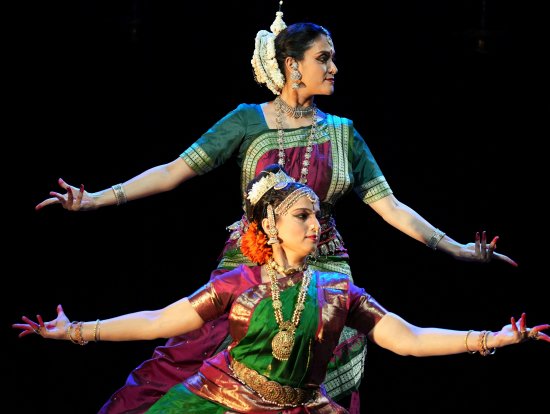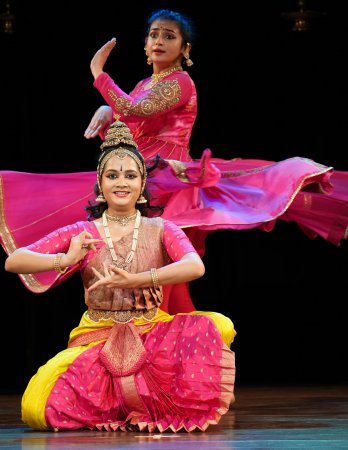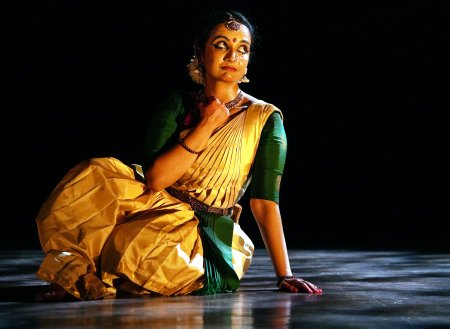
|   |

|   |
A tapestry of dance: Diverse performances take the stage - Satish Suri e-mail: satishism@yahoo.co.in Photos: Prof. K.S. Krishnamurthy March 7, 2024 DELIGHTFUL FUSION OF EMOTIONS Atmica Reddy and Vinita Radhakrishnan, trained in Bharatanatyam under different gurus, presented a captivating performance on the 17th of February at Seva Sadan, that seamlessly fused their diverse training streams. Atmica Reddy received training from Vani Ganapathy and Praveen Kumar, while Vinita Radhakrishnan trained under Minal Prabhu and Indira Kadambi. Despite their varied backgrounds, the duo showcased remarkable insight and artistry, demonstrating a harmonious blend of Bharatanatyam techniques.  Vinita and Atmica Their presentation unfolded with a vibrant Mallari, setting an energetic ambience that persisted throughout the performance. A significant highlight was their interpretation of the pada varnam "Chalamela chesevayya," where they delved into the intricacies of devotion and longing. Under the tutelage of Guru Minal Prabhu, the choreography transcended conventional boundaries, offering a unique portrayal of contrasting emotions. Vinita's exploration of the devotional aspect demonstrated depth and sincerity. Particularly in the line "kalakaalamu nee padamule nammiyunna," she conveyed a sense of absolute surrender to the will of the Lord with sincerity and conviction. In contrast to Vinita's devotional narrative, Atmica's portrayal explored the theme of unrequited love with poignancy and intensity. Her interpretation of the Nayika conveyed the anguish and longing of a lover yearning for her beloved Lord. Through subtle emotive expressions, Atmica captured the essence of the Nayika's emotional turmoil, drawing the audience into her world of heartache and desire. Despite portraying contrasting emotional narratives, Vinita and Atmica demonstrated remarkable chemistry and synchronization on stage. Their performance complemented each other seamlessly, enhancing the overall impact of the piece. Whether portraying scenes from Gajendra Moksham or the saving of Draupadi's honour, their movements flowed harmoniously, reflecting their shared understanding. Their ability to blend technical precision with emotive storytelling showcased their versatility as dancers and added layers of richness to the performance. Furthermore, the choreographic choices and stagecraft by Minal Prabhu demonstrated a nuanced understanding of storytelling within the Bharatanatyam framework. Atmica showcased her talent through a vibrant solo featuring the Tamil padam "Netrandhi nerathile" composed by Subbarama Iyer in Husseini raga. Choreographed by her Guru Vani Ganapathy, this piece was a highlight of her arangetram. The song portrays a playfully jealous heroine confronting her beloved Lord Subramanya about another woman who flirted with him the previous day. Atmica's performance skillfully conveyed the woman's playful accusations and the deeper emotions underlying her jealousy, capturing the essence of the song with grace. Vinita's rendition of the ashtapadi "Ramate Yamuna pulina bane", was a moving account of Radha's complaint about her beloved Lord Krishna. She suspects that he is spending time with another woman on the banks of the Yamuna and wonders sadly why she should pine for him. Vinita's sensitive portrayal of the emotional canvas of a lovelorn nayika was commendable. Her abhinaya blossomed with the rasa bhava (emotional essence) of the ashtapadi, the emotional turmoil of Radha who is torn between love and doubt. Vinita's nuanced interpretation captured the complexities of human emotions, allowing the audience to empathize with the character's inner conflict. Vinita graciously acknowledged the guidance and support of her Guru Minal Prabhu and Aruna Mohanty, in the rendering of the piece. The day's proceedings concluded with a vibrant Thillana in Jog raga, composed by G. Gurumurthy and Balasubrahmanya Sharma. The orchestra led by Balasubrahmanya Sharma on vocals, Minal Prabhu on nattuvangam, G. Gurumurthy on mridangam, and Jayaram Kikkeri on flute, added richness and depth to the artistes' rendition. EXPLORING LIFE'S ESSENCE: 'ROOTS' BY AMEYA REPERTORY 'Roots' is a Bharatanatyam performance that delves into the profound concept of life and growth, inspired by a serendipitous encounter with exposed tree roots in the Nilgiri Hills. Choreographed by Chitra Chandrasekhar Dasarathy and performed by the Ameya Repertory from Bangalore, on the 19th of Feb at the Bangalore International Centre, the performance transcends the physicality of roots to explore deeper metaphors of resilience, striving, and the human experience. In this artistic rendition, roots symbolize more than just a physical structure; they represent the unseen forces that shape and nourish life. Like roots drawing nutrients from the earth, humans assimilate experiences and spread the 'sap of life' through their actions and interactions with the world around them. The performance imagines a narrative where roots become a reflection of identity, connection, and the cyclical nature of existence.  Ameya Repertory The dancers Chitra Chandrasekhar Dasarathy, Gargi Shroff, Roopa Guha, Sreejaya Nair, Supriya Auradkar, Swetha Vivek and Tony Pius embodied the essence of roots, portraying their strength, resilience, and interconnectedness with the earth. The choreography evoked the imagery of roots spreading and intertwining, reflecting the complex network of relationships and experiences that shape human existence. As the performance unfolded, the dancers evoked a sense of movement and growth, mirroring the cyclical rhythms of nature. They explored themes of transformation, adaptation, and renewal, drawing parallels between the growth of roots and the evolution of the human spirit. The choreography's emphasis on dancers performing predominantly on their toes while using their palms to tap rhythms on the stage floor added a layer of complexity to the narrative. These movements enriched the storytelling aspect of 'Roots' by adding texture, depth, and symbolism to the performance. It highlighted the dancers' ability to convey meaning and emotion through their physicality while immersing the audience in a visually and aurally captivating experience. Through its evocative imagery and poignant storytelling, the performance invites audiences to embark on a journey of self-discovery and contemplation, ultimately reminding us of the enduring power of our collective roots. In the final episode titled 'Manjal,' the performance explores the significance of turmeric, known as 'manjal' in Tamil, across various cultural contexts. The narrative depicts the journey of turmeric from its humble origins as a root to its transformation into a versatile ingredient with culinary, cosmetic, and ceremonial uses. The segment highlights the laborious process of picking and pounding turmeric, symbolizing the efforts involved in its preparation. It showcases turmeric's role as a spice in cooking, as a key ingredient in skincare rituals and as a symbol of blessings and purity in ceremonies like the Haldi ceremony. The culmination of the performance portrays the final merger of turmeric into the silence of creation, symbolizing its integral role in the cycle of life. This fitting finale underscores the profound symbolism associated with turmeric and its importance in both practical and spiritual aspects of human existence. The music composition, on a recorded track orchestrated by Praveen D. Rao and assisted by Pramath Kiran, Varijashree Venugopal, M.D. Pallavi, Struthi Kamath, and Gopal Venkatramana played a pivotal role in shaping the performance's ambience and emotional depth. Through a haunting and melodic soundscape, the music elevated the production values, infusing the performance with grace and refinement. The haunting melodies evoked a sense of mystery and wonder, echoing the enigmatic nature of roots and the hidden world they represent. From ethereal flutes to resonant percussion, the diverse instrumentation added layers of texture and depth to the performance, enhancing its emotional impact. CITSABHA COLLECTIVE 'Swadhyaya' presented by the Citsabha Collective, was a captivating showcase of classical dance forms, curated by the talented dancers Srividya Angara and Shubha Nagarajan. The performances held on February 25th at Seva Sadan, Bangalore, aimed to offer a platform for exceptionally skilled artistes to exhibit their talents and celebrate the richness of Indian dance traditions.  Srividya Angara and Shubha Nagarajan The evening commenced with a performance titled 'Samaagati' which opened with a heartfelt homage to Lord Ganesha, setting the stage for a captivating narrative inspired by Adi Shankara's Meenakshi Pancharatna. Through this choreography, the audience embarks on a vivid journey through the extraordinary life of Meenakshi. Born from fire with three breasts, she undergoes rigorous training in warfare and warcraft, emerging as a fearless and formidable warrior. With unmatched valour, she conquers every realm, earning admiration and respect on the battlefield. As the narrative unfolds, Meenakshi encounters Lord Shiva as Sundareswara, and a profound love blossoms between them. Eventually, they unite in marriage, and miraculously, she loses her third breast, transforming into the radiant and resplendent Meenakshi. This transformation symbolizes her completeness and divine femininity, marking the culmination of her epic journey. 'Samaagati' weaves together elements of mythology, history, and spirituality, offering a mesmerizing portrayal of Meenakshi's courage, strength, and eventual transformation. Samaagati is a musical dialogue between two dancers, demonstrating the seamless fusion of Kuchipudi and Odissi styles. Srividya Angara, renowned for her expertise in Kuchipudi, and Shubha Nagarajan, an accomplished Odissi dancer, mesmerized the audience with their synchronized movements, intricate footwork, and graceful expressions. Their performance exemplified the beauty and diversity of Indian classical dance forms, as they seamlessly blended the unique aesthetics of Kuchipudi and Odissi. The subtle use of Kalaripayattu techniques allowed the dancers to depict Kamakshi's courage, agility, and martial skills with precision. From intricate hand gestures to dynamic body movements, each gesture and stance conveyed the strength and determination of the character, bringing Kamakshi's character to life in a compelling manner. The recorded music track played a significant role in enhancing the overall aesthetic appeal and impact of the presentation. It provided a rich and immersive auditory experience that complemented the dancers' movements and storytelling, creating a harmonious fusion of music and dance.  Rohini Prabath and Medhavani Varkhed In the jugalbandi performance between Bharatanatyam and Kathak, Medhavani Varakhedi and Rohini Prabhath showcased their exemplary skills. The piece began with 'Sargam,' a musical composition that seamlessly blended elements from Hindustani and Carnatic music traditions. Rohini's Kathak presentation was characterized by the graceful movements typical of the dance form, interspersed with intricate rhythmic patterns. Her performance evoked the imagery of spring, with vibrant expressions and dynamic footwork. The chakkars added an element of dynamism and energy to her rendition, captivating the audience with their fluidity and precision. On the other hand, Medhavani's Bharatanatyam performance was marked by the distinct karanas, or dance postures characteristic of the style. Her movements were expressive and evocative. As she synchronized her movements with the music, she brought out the lyrical beauty of the composition, captivating the audience with her grace and artistry. Together, Medhavani and Rohini complemented each other's performances, blending the distinct elements of Bharatanatyam and Kathak to create a harmonious and captivating visual spectacle. Following the jugalbandi performance, the audience was treated to a light and delightful exposition choreographed by their gurus Nirupama and Rajendra, set to a composition by Purandaradasa. This piece humorously depicted a playful argument between the goddesses Parvati and Lakshmi about the superiority of their respective husbands, Lord Shiva and Lord Vishnu. Parvati begins the banter by teasingly criticizing the various forms of Lord Vishnu, including his incarnations as a fish and a turtle, which live in water. Lakshmi counters by pointing out that Shiva resides in the masaan or the cremation grounds, and Vishnu himself assumes forms that are not conventionally pleasant. The banter continues as the goddesses compare the attributes of their husbands, highlighting their unique characteristics and appearances. However, the argument takes a humorous turn when both Parvati and Lakshmi realize that despite their differences, Hari (Vishnu) and Hara (Shiva) are ultimately the same. Rohini and Medhavani executed the choreography with precision and finesse, showcasing impeccable abhinaya. Their jestful expressions and lively gestures brought the playful argument between Parvati and Lakshmi to life, captivating the audience. The performance culminated with a scintillating Tani Avartanam, a percussion solo composed by Fayaz Khan. This vibrant rhythmic composition echoed the artists' proficiency and training under their Gurus Nirupama and Rajendra. With intricate rhythmic phrases and dynamic patterns, the Tani Avartanam showcased the dancers' mastery of rhythm and their ability to synchronize seamlessly with the music. It served as a fitting conclusion to the performance.  Shruti Gopal The concluding performance for the day was a solo Bharatanatyam performance by Shruti Gopal, Artistic Director of Upadhye School of Dance. She began her performance with a Varnam in raag Charukesi titled "Innum en manam" which showcased the Nayika's poignant questioning of Lord Krishna's apparent indifference to her feelings. Choreographed to Lalgudi Jayaraman's composition, the dancer used captivating sanchari bhava to convey the Nayika's deep longing for Krishna, juxtaposed with his perceived indifference. As the performance unfolded, the dancer adeptly transitioned between layers of interpretation. Initially, the abhinaya focused on the literal meaning of the lyrics, but as the composition progressed into the charanam refrain, such as "Kuzhaloodum azhaga Kanna kurai teerayo," the dancer's expression deepened, revealing the Nayika's inner emotional turmoil. Here, the dance blossomed into elaborate portrayals, depicting all creatures of Nature mesmerized by Krishna's divine flute melody, symbolizing the universal allure of his presence. A notable aspect of the performance was the incorporation of Jati Teermanams, rhythmic sequences that infused dynamic energy into the dance. Executed with precision and flair, these sequences not only complemented the narrative but also showcased the dancer's technical prowess and mastery over rhythm, enhancing the overall impact of the performance. The ghazal "Aaj jaane ki zid naa karo" was masterfully interpreted by the artiste, who skillfully incorporated lines from Vyasatirtha's composition "Krishna nee begane baro" to add a unique flourish to her exposition. Through body language, facial expressions and gestures, the artiste conveyed the emotional depth and complexity of the lyrics. The plea to not be stubborn and to seize the precious moment resonated powerfully, emphasizing the transient nature of time and the significance of cherishing the present. Shruti concluded her performance with a Bhajan titled "Mata Kalika" which delves into the stories and symbolism surrounding the deity Kali. Known for her fearsome form and intrinsic beauty, Kali embodies both aspects of destruction and creation. The artist captured the complexity of the deity's character through her expressive movements and artistic creativity. By infusing the performance with elements of devotion and reverence, the dancer honoured the divine feminine energy embodied by Kali, leaving a lasting impression on the audience.  Bangalore based Satish Suri is an avid dance rasika besides being a life member of the Music and Arts Society. |